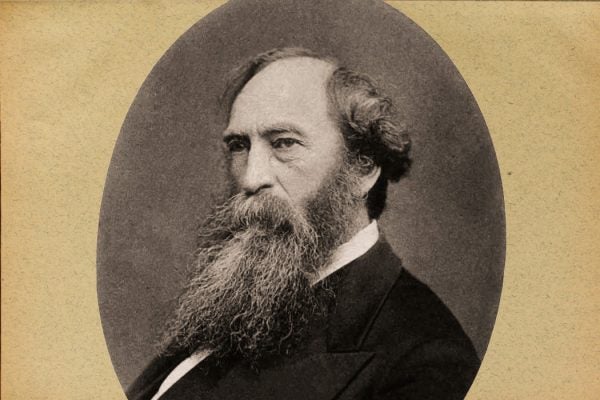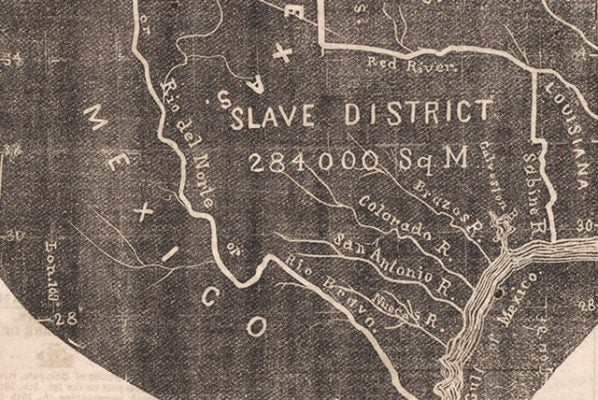In 1843, a New England lawyer almost managed to sell Texas to Great Britain. A convinced abolitionist practicing law in what was then the independent Republic of Texas, Stephen Pearl Andrews got it into his head that, in an attempt to free Texas’s slaves, he would invite a foreign power into North America and hand over a massive chunk of it. Andrews’s attempt to free Texas’s slaves by way of an invitation to foreign interference illustrates the strange bedfellows created by “the slavery question” in the nineteenth century. Andrews, in his quixotic vision, in his idealism, ambition, and occasional crankery, was an exemplary nineteenth-century American figure.
Andrews spent his late teens and early twenties teaching at a girls’ school in New Orleans opened by his brother and sister-in-law, where he was exposed to the reality of slavery. He grew close to a man named George, a slave at the Andrews’s school, who went about his work with a cheerful attitude until, one night, confiding as to the true nature of his condition. George’s reports of his own sorry treatment at the hands of his owners, from the everyday indignities to whippings, left Andrews with “a profound impression… of the tremendous power of that great national machinery of oppression, American Slavery.” That impression never left him.
Audio brought to you by curio.io
After studying law and acquiring a number of languages in Louisiana, Andrews departed for Texas, then still an independent republic where slavery was legal. In Houston, he studied Texas law and opened a practice, earning money for his legal work but mostly acquiring wealth through purchasing land. He took on an increasingly prominent role in Houston society, speaking before the city’s temperance society and getting himself appointed to the Committee of Vigilance of Houston to solicit funds for Texas’s military. At the same time, his anti-slavery sentiments sharpened into full-blown abolitionism.
In 1841, Andrews hatched a plan to make his political and moral beliefs a lived reality: He would convince Great Britain to buy up all the land in Texas on the condition that they free Texas’s slaves. The idea was not as outlandish as it might sound. In 1833, Great Britain had done something similar in abolishing slavery on its plantations in the West Indies. There, slaveholders were paid a total of $20 million sterling in recompense for their lost property, though they retained the land. And Texas had already reached across the Atlantic for economic aid. The South Carolina politician James Hamilton had recently attempted to borrow $5 million from European nations in support of Texas.

As the historian Charles Shively recounts in the Journal of Negro History, “Hamilton had failed in part because of the English abolitionists’ opposition to Texas slavery. Except for his emancipation proposal, Andrews’ program followed the same lines as that of Hamilton.” Given the American interest in annexing Texas into the United States, the Republic’s sparse population, and military pressure from Mexico, Andrews hypothesized that Texas slaveholders and landowners, rather than taking their chances on land speculation, would be amenable to a cash buy-out, the terms of which would include abolishing slavery. As Madeline Stern, Andrews’ biographer, explains in an article for The Southwestern Historical Quarterly:
By the exchange of British money for Texas land, slaveholders could be reimbursed for the loss of their slaves and slavery could be abolished; [British] emigrants would pour into a ‘free soil territory’ and under the protection of the British flag expediency would be made to serve principle.
It did not seem to bother Andrews that his plan would hand a large chunk of North American territory over to Great Britain. Nor did it seem to bother the abolitionist leaders whom he informed of his plan, including Lewis Tappan, a successful businessman, energetic abolitionist, and former client of Andrews’s. Tappan agreed to use his influence in Great Britain. Nor still did it seem to bother anyone that neither Andrews nor Tappan were authorized by the Texas government to do any of this. Andrews, who was a compelling speaker, did take his plan to the public, announcing his intention to raise funds from Great Britain to buy Texas land. And while he was denounced as an abolitionist, he won the crowd over.

When he tried to do the same on the island of Galveston, the most populous city in Texas after Houston, it was a different story. After going from plantation to plantation attempting to convince skeptical, if not outright hostile, slaveholders that it would be in their interest to go along with the plan, he attempted to hold another public meeting. This one was snuffed out before it began, and an armed mob assembled in front of the Custom House. They escorted Andrews and his entourage to a boat headed back to the mainland.
Back in Houston, public sentiment turned against him. Correspondence between one of Andrews’s associates and a friend in London concerning the plan had leaked to the press. Andrews’s plans for Texas were a matter of public record. News of a radical abolitionist plot hatched by a “negrophilist” meddler circulated. Whatever political, economic, and military pressures weighed on Houston, they were not great enough to overcome its investments in slavery and its anger at the prospect of colonization by Great Britain. When Andrews returned, another mob formed, rope in hand, this time at Andrews’s home. The threat was credible enough to lead Andrews to abandon his practice, sell his land, and flee to New Orleans under cover of night, with his wife and son. But New Orleans offered no safe haven either. As Stern informs us, the police in New Orleans had been ordered to arrest Andrews on sight. After a few days, he took his family north to Mississippi and then east, leaving them in Norwich, Connecticut.
Get Our Newsletter
Despite the danger, Andrews remained undeterred. With letters of introduction in hand, Andrews and Tappan sailed for Liverpool from Boston on June 1, 1843. Upon landing, they were introduced around England’s anti-slavery circles, gave speeches in support of their plan, and formed a committee to make their pitch to the seemingly sympathetic British Foreign Secretary and future Prime Minister Lord Aberdeen. After Tappan addressed him, Andrews laid out his case. As Stern writes:
His objects were to prevent the annexation of a slave state to the Union, to curtail the extension of slavery over the country, and to persuade the British government either to lend over a million pounds or more than five million dollars to Texas on security of her public lands or to raise such a sum in exchange for lands in Texas, on condition that the republic would amend her constitution to abolish slavery.
…
The money advanced would be applied to the purchase and emancipation of the slaves and would serve as an indemnity for the abolition of slavery. If Britain guaranteed the payment of the interest on a loan, then Texas would not only free her slaves, but pledge not to be annexed to the United States.
Aberdeen seemed to think the plan worthwhile, and Andrews and Tappan went about drumming up more support, drafting documents, and meeting more contacts in England. Neither of them realized that the charge d’affaires from Texas to England, Ashbel Smith, had already been in contact with Aberdeen for some time, well before the voyage to Liverpool. In fact, Smith had gone along in person to England, where he kept tabs on Andrews and made clear to Aberdeen that neither Andrews nor Tappan had the authority to make the kind of deal proposed, and that such an offer would be unwelcome. Though Aberdeen was no supporter of slavery, he did not want to interfere in Texas, which was even then beginning the process of annexation into the Union as a slave state.
Andrews had no idea of this as he boarded a ship back home to America. In the coming weeks, he would find himself mocked and excoriated in the press. He had failed. His effort, after all, has a hint of treason about it, even if it was treason that served a clear moral principle. It is easy to imagine ordinary people reacting viscerally against the idea of a backroom deal orchestrated by people elected by no one, giving a foreign power land and influence in North America.
Andrews went on to spend the rest of his life setting up a stenography practice and writing grand, abstruse books of economics, political theory, sociology, and speculative philosophy. He founded a utopian community in the Pine Barrens on Long Island called Modern Times. It was established partially on the social and economic principles outlined in his book The Science of Society (1850), which involved a money system in which residents exchanged tokens denoting certain lengths of labor-time for goods and services. His society, less than fully isolated, also failed. He spent his latter years supported by a handful of followers, who listened to him speak and read his writings. But he would never again achieve the degree of influence or infamy he attained in the early half of the century as a seditious abolitionist.







